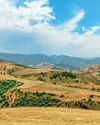
AS YASMEEN LARI LOOKED out the car window across the Siran Valley in northeastern Pakistan, she grieved for what was no longer a lush vale with rolling green hills, trees and mountains. It was October 2005, and the catastrophic earthquake that had killed some 79,000 people in Pakistan, India and Afghanistan a week earlier had reduced the valley to mud and rubble.
The 65-year-old architect was there to help lead the reconstruction of settlements, but she had never done disaster work before. Lari was filled with anticipation after a two-hour flight from Karachi to Islamabad, Pakistan’s capital, followed by this five-hour drive.
Darkness had fallen before her driver pulled into a dimly lit army camp where the military rescue operation was based; at 1,500 metres it was safer from aftershocks and rock slides than lower ground. When she stepped out of the car she was taken to the commanding officer, who talked to her about the villages that needed immediate help. The enormity of the task ahead hit her full force.
Lari, who had become Pakistan’s first female architect in 1964, was renowned for designing slick towers of glass and concrete. But here, she’d be drawing plans for earthquake-resistant homes using stone and timber debris. Working from a rough cottage near the camp, she’d spend the next four months working with volunteer architects and engineers from Pakistan and abroad.
She would send her drawings with the volunteers, who walked through difficult terrain to reach mountain hamlets. There, they’d assist displaced families with sorting debris and building new and improved homes, even as temperatures plunged and snow began to fall.
This story is from the {{IssueName}} edition of {{MagazineName}}.
Start your 7-day Magzter GOLD free trial to access thousands of curated premium stories, and 9,000+ magazines and newspapers.
Already a subscriber ? Sign In
This story is from the {{IssueName}} edition of {{MagazineName}}.
Start your 7-day Magzter GOLD free trial to access thousands of curated premium stories, and 9,000+ magazines and newspapers.
Already a subscriber? Sign In

Demonstrators by Krishna Reddy
1968 Multicolour viscosity, Print on paper

Notes from Grief Camp
Every summer, more than a hundred children come together to spend a weekend swimming, climbing and canoeing. They also learn to deal with death

Six Places Cheese Lovers Should Visit
Ancient caves, monasteries, and other must-sees for fromage fans

THE LAND OF SUPERCEN TENARIANS
A remote region of Azerbaijan claims to have many extremely long-lived residents. What is their secret, or is it just a myth?

The Whistle Blowers
My grandparents had a distinctive way of communicating

"THE NEXT AIRCRAFT WILL CRASH ON LANDING"
THE JET WAS ALMOST OUT OF FUEL. THE PILOTS' ONLY OPTION WAS A MANOEUVRE NO ONE HAD EVER ATTEMPTED.

The Secrets in our Genes
Genomic sequencing tests can reveal much about your unique physiology. But are they worth it?

GOOD NEWS FROM AROUND THE WORLD
MENTAL HEALTH When her son was arrested last year, Tambudzai Tembo's mind went to dark thoughts of suicide.

Into the Inferno
A gas station owner has seconds to react when a car crashes into a gas pump

THE CLIMATE CHANGERS
THESE PLACES ARE LEADING THE WAY TO A FUTURE FREE OF FOSSIL FUELS